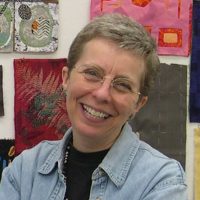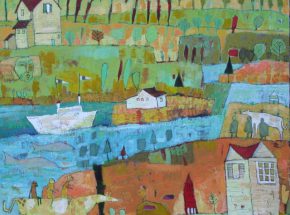

Susan Brandeis is Distinguished Graduate Professor of Art and Design at North Carolina University, where she has taught at the College of Design since 1982. She serves as the Director of Graduate Programs for the Department of Art and Design, coordinates undergraduate and graduate studies in Fibers and Surface Design; is a founding member of the Anni Albers Scholars Program faculty. She holds a Master of Science degree in Art Education from Indiana University and a Master of Fine Arts in Textile Design from the University of Kansas. She works with a wide range of students whose interests span the spectrum from designing textiles for mass production to creating one-of-a-kind art works. The teaches a wide range of courses in the textile arts and design including surface design, screen printing, dyeing, digital printing, fibers materials and processes, off-loom structures, embroidery, pattern, and color; as well as seminar courses in textile history, research methods, and contemporary issues.
Her creative work has focused on continuing investigations in dyeing and printing both industrially produced and hand-woven fabrics, the juxtaposition of pattern and color, the contrast of materials and textures, and digital printing and embellishment. Her explorations are directed toward developing a visual “language” of materials and techniques which communicates the essential qualities found in nature, inspired by hiking and visiting places of great natural beauty. Her art works for the wall have been published in the books Celebrating the Stitch, The Surface Designer’s Art, The Art Quilt, Freestyle Machine Embroidery, and Contemporary Quilt Art, and in leading craft and textile art magazines such as American Craft, Fiberarts, and Surface Design Journal, and have been exhibited throughout the United States and in England, Ireland, Finland, Japan, Korea, the Netherlands, Colombia, at the International Biennial of Tapestry in Lausanne, Switzerland, and at the Textile Museum in Washington, DC. She is represented in numerous private and public collections, including the Renwick Gallery of the Smithsonian. She has taught summer workshops at Penland School of Crafts (North Carolina), Arrowmont School of Arts and Crafts (Tennessee), Haystack Mountain School of Crafts (Maine), Oregon College of Arts and Crafts (Oregon), and the Split Rock Arts Program (Minnesota). She is recipient of three visual arts fellowships from the North Carolina Department of Cultural Resources and a member of the Academy of Outstanding Teachers, North Carolina State University.
Making a textile is a kind of magic. My early lessons with mother and grandmother taught me sewing, knitting, crocheting, embroidering, and quilting. Those experiences planted the seeds that have grown into my passion for making textiles by hand and my understanding of the powerful combination of materials, techniques, skill, craft, imagination, and spirit.
I make textiles because I love the rhythm of repetition and pattern, complex color contrasts, textured relief surfaces, and the feel of the materials in my hand. I savor the slow meditation of making as an antidote to life’s rush and bustle. I choose simple, natural materials for their honest liveliness. I avoid trends to search for an enduring aesthetic. While the ideas are mine, the work is not about me. I prefer images and concepts that transcend the personal to touch universal human themes. Fabric work has become as natural for me as breathing, and its expressions a “language” often more eloquent than speech.
For over three decades, I have used nature and natural phenomena as the subject matter for my work, developing dyeing, printing, piecing, weaving, and stitching techniques to construct complex relief surfaces. The works have evolved from grand views and generalized effects, to the power and uniqueness of more specific places and moments in nature; from exuberance and celebration, to elegance and poetry. Both my sources of inspiration and the images I make have become more intimate, heartfelt, quiet, and reflective.
I often use the contrast of panels in a single piece to allow the viewer multiple simultaneous glimpses: close views next to distant ones, views toward the horizon or from above-mimicking the way we see our surroundings. We look to the distance, we look at what is close to us, we turn, we change focus, our eyes move about because we cannot take in everything at once. I use multiple works in a series to speak more comprehensively about the experience of a special place.
My approach allows me to work with a wide variety of textiles techniques and materials, including the use of digital printing on fabric and recycled textiles. Each piece I make requires different technologies-many by hand, some with the computer. It is the balance among them that makes my current working process satisfying-and still magical.
Website
http://www4.ncsu.edu/~brandeis/
